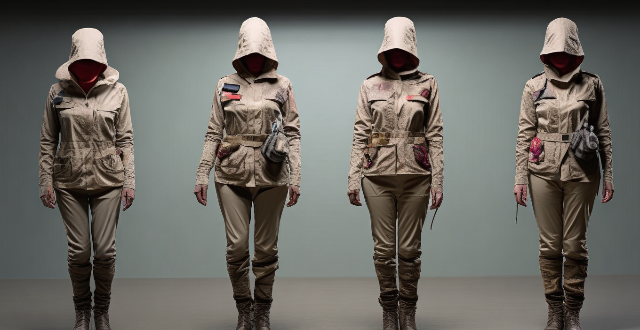Insect Clothing

What kind of clothing should I pack for a trip to Africa ?
When packing for a trip to Africa, it's important to consider the climate and culture of the region you'll be visiting. Here are some essential clothing items to pack: - Lightweight and breathable fabrics such as cotton, linen, and rayon. - Long sleeve shirts and pants to protect your skin from the sun and insects. - A wide-brimmed hat to shade your face and neck. - Comfortable walking shoes or sandals with good support. - A light jacket or sweater for cooler evenings. - Sunglasses and sunscreen with high SPF protection. - Insect repellent to keep mosquitoes and other bugs at bay. It's also important to dress respectfully when traveling in Africa. Many African countries have conservative dress codes, especially in rural areas. Here are some tips to keep in mind: * Avoid wearing revealing or tight-fitting clothing. * Cover your shoulders and knees when visiting religious sites or conservative communities. * Women may want to bring a scarf or pashmina to cover their hair in certain situations. * Avoid wearing excessive amounts of jewelry or expensive accessories, as this can attract unwanted attention. The climate in Africa varies widely depending on the region and season. Here are some general guidelines for different seasons: Dry Season (November to April): * Lightweight clothing made of natural fibers like cotton and linen. * Shorts, skirts, and t-shirts for hot weather. * A light jacket or sweater for cooler evenings. * Sunglasses and sunscreen with high SPF protection. Wet Season (May to October): * Waterproof jacket or raincoat. * Quick-drying clothes that can be easily washed and dried. * Warm layers for cooler temperatures, especially in the evenings. * Insect repellent to keep mosquitoes and other bugs at bay. Year-Round Tips: * Pack clothing in neutral colors that can be mixed and matched easily. * Bring comfortable walking shoes or sandals with good support. * Don't forget a swimsuit if you plan on going to the beach or taking part in water activities. * Pack a small first aid kit with basic supplies like bandages, antiseptic wipes, and pain relievers.

What should I pack for a photography trip to a tropical destination ?
When planning a photography trip to a tropical destination, it's essential to pack the right gear and clothing to ensure you capture stunning images while staying comfortable and protected from the elements. Here are some items you should consider packing: Camera Gear: Primary camera body, backup camera body, variety of lenses, sturdy tripod, filters, high-capacity memory cards, extra batteries and charger, cleaning kit. Clothing and Accessories: Lightweight clothing made from natural fabrics like cotton or linen, waterproof jacket or raincoat, hat and sunglasses, sunscreen, insect repellent, comfortable shoes suitable for walking on uneven terrain or hiking trails, swimwear if you plan to swim or snorkel. Miscellaneous Items: Comfortable backpack or camera bag with enough space to carry all your gear and personal belongings, reusable water bottle filled with clean drinking water, snacks like energy bars, nuts or fruits to keep your energy levels up during long shoots or hikes, small first aid kit with essential items like bandages, antiseptic wipes, pain relievers and any prescription medications you may need, guidebooks or maps of the area you'll be exploring to help you navigate and find interesting locations to photograph.

How should protective clothing be properly disposed of after use ?
Proper Disposal of Protective Clothing After Use: - Remove clothing carefully in a designated area to avoid cross-contamination. - Place used clothing in a sealable plastic bag and seal tightly. - Label the bag with "Biohazard" or "Contaminated" and include the date and time of disposal. - Dispose of the bag properly according to your organization's protocols or local waste management facility guidance. - Clean and disinfect the area where you removed your protective clothing. - Wash your hands thoroughly with soap and water for at least 20 seconds. - If exposed to a contagious disease, monitor for symptoms and seek medical attention if necessary.

How often should protective clothing be replaced or cleaned ?
Protective clothing is essential in various industries and situations to ensure the safety and health of workers. It is crucial to maintain the effectiveness of protective clothing by replacing or cleaning it regularly. The frequency of replacement or cleaning depends on various factors such as the type of protective clothing, level of exposure, manufacturer's recommendations, and personal hygiene. Disposable protective clothing should be replaced after each use, while reusable protective clothing can be cleaned and reused multiple times. Always follow the manufacturer's recommendations and maintain personal hygiene by changing into clean protective clothing when necessary. By doing so, you can ensure the effectiveness of protective clothing in preventing contamination and protecting workers from hazardous substances.

What are the different types of protective clothing available ?
Protective clothing is essential in various industries and environments to ensure the safety and well-being of individuals. It is designed to protect against hazards such as chemicals, biological agents, radiation, heat, cold, electrical shocks, and physical injuries. There are different types of protective clothing available, including chemical protective clothing, biological protective clothing, radiation protective clothing, thermal protective clothing, electrical protective clothing, and physical protective clothing. Each type of protective clothing is designed to protect against specific hazards and includes a range of garments and accessories.

What are the most common materials used in the production of protective clothing ?
Protective clothing is designed to safeguard individuals from hazardous environments or conditions. The materials used for such garments play a crucial role in providing the necessary protection while ensuring comfort and functionality. In this article, we will explore the most common materials used in the production of protective clothing: Polyester, Cotton, Nylon, Neoprene, and Gore-Tex.

How do smart fabrics work in sports clothing ?
Smart fabrics in sports clothing incorporate conductive threads and sensors to monitor movements, vital signs, and environmental factors. They provide real-time feedback for performance enhancement and injury prevention. Features like thermoregulation and self-cleaning improve comfort and durability. Integration with devices allows for a seamless user experience, while customization options offer personalized fits and designs.

How do moisture-wicking fabrics enhance sports clothing ?
Moisture-wicking fabrics significantly enhance sports clothing by improving comfort, performance, and durability. They pull sweat away from the body, reducing stickiness and helping maintain a stable body temperature. These fabrics are lightweight, breathable, and quick-drying, which enhances physical activity. Their resistance to shrinkage and stretching ensures longevity. Moisture-wicking fabrics work through capillary action and efficient evaporation, speeding up the drying process. They are widely used in base layers, athletic wear, and accessories like headbands and socks, providing comfort during extended activities. Overall, these fabrics are crucial for modern sports apparel, offering practical benefits for athletes and fitness enthusiasts.

What role does clothing play in developing a professional image ?
Clothing plays a crucial role in developing a professional image by impacting first impressions, communicating professionalism, and influencing perception. It can also promote diversity and inclusion in the workplace. By dressing appropriately for the job or industry, you set a positive tone for your professional interactions, boost confidence, enhance credibility, and represent your personal brand or company. Adhering to dress codes demonstrates an understanding and respect for the culture of your field, while neat and well-organized attire shows attention to detail. Studies suggest that dressing more formally can make you appear more competent and knowledgeable, while appropriate clothing can also make you seem more approachable and adaptable. Allowing some degree of personal expression through clothing can promote diversity and individuality within the workplace, while respectful dressing can acknowledge diverse cultural backgrounds in a multicultural work environment. Overall, clothing is a tool for communicating your professional identity, and finding the right balance between professionalism and personal style is key to enhancing your professional image and effectiveness.

What is the difference between disposable and reusable protective clothing ?
The article discusses the differences between disposable and reusable protective clothing in terms of their usage, durability, cost, and environmental impact. Disposable protective clothing is made from lightweight materials and designed for short-term use, while reusable protective clothing is made from more durable materials and designed for long-term use. The choice between the two depends on factors such as budget, frequency of use, and level of protection required.

What are the benefits of wearing protective clothing in a laboratory setting ?
In a laboratory setting, wearing protective clothing is crucial for the safety and well-being of individuals working with hazardous materials or conducting experiments that may pose risks. The benefits of wearing protective clothing include protection from chemical spills and splashes, biological hazards, personal comfort and hygiene, and compliance with safety regulations. By prioritizing safety through proper protective clothing, laboratory personnel can work more confidently and efficiently while minimizing potential risks to their health and well-being.

What's the best way to treat set-in stains on white clothing ?
Set-in stains on white clothing can be stubborn and difficult to remove, but with the right approach, they can often be successfully treated. Here are some steps to follow: 1. Identify the Stain: First, identify the type of stain you are dealing with. Different stains require different treatments. For example, protein stains like blood or grass require a different approach than tannin stains like tea or coffee. 2. Act Quickly: The sooner you treat a stain, the easier it is to remove. If the stain is still wet, blot it with a clean cloth or paper towel to remove as much of the substance as possible. 3. Pre-Treat the Stain: Before washing, pre-treat the stain with a suitable stain remover. Choose a product that is safe for use on white clothing and apply it directly to the stain following the instructions on the label. Let it sit for the recommended time. 4. Wash in Hot Water: Wash the garment in hot water, using a detergent that is designed for white clothing. Check the care label on your garment to ensure that it can be washed in hot water. If not, use the warmest water recommended. 5. Use Chlorine Bleach if Necessary: If the stain persists after washing, you can use chlorine bleach. However, be sure to check the care label on your garment first. Some fabrics may not be able to handle bleach. If your garment is made of a material that can be safely bleached, add chlorine bleach to the wash cycle according to the package instructions. 6. Rinse Thoroughly: Rinse the garment thoroughly to remove all traces of the stain and any cleaning products used. 7. Dry and Check: Dry the garment and check to see if the stain has been removed. If not, repeat the process before drying again. Once the stain is gone, you can dry the garment as usual. In conclusion, treating set-in stains on white clothing requires patience and persistence. By identifying the stain, acting quickly, pre-treating, washing in hot water, using chlorine bleach if necessary, rinsing thoroughly, drying, and checking, you can often successfully remove even the most stubborn stains.

Can you explain the different levels of chemical resistance in protective clothing ?
Chemical resistance is a crucial aspect of protective clothing, especially for those working in hazardous environments. The level of chemical resistance required depends on the type and concentration of chemicals present in the work area. Here, we will discuss the different levels of chemical resistance in protective clothing: 1. Level A: Highest Level of Protection 2. Level B: Intermediate Level of Protection 3. Level C: Lower Level of Protection 4. Level D: Basic Protection

What should I pack for a cultural exploration journey ?
When embarking on a cultural exploration journey, itWhen embarking on a cultural exploration journey, it that will enhance your experience and it is important to pack items that will enhance your experience and ensure your comfort throughout the trip. Essential items include comfortable walking shoes, lightweight clothing, culturally appropriate attire, camera, portable charger, travel adapter, sunscreen, insect repellent, basic toiletries, reusable water bottle, daypack, and travel journal. Research the specific needs and customs of the culture you will be visiting to tailor your packing list accordingly.

What should I pack for a nature and wildlife adventure ?
This packing list outlines essential and optional items for a nature and wildlife adventure. Essential items include appropriate clothing, equipment such as a backpack and tent, food and water supplies, safety and first aid provisions, and miscellaneous items like insect repellent and sunscreen. Optional items may include entertainment, personal items, and extra gear such as trekking poles and dry bags. It is important to pack according to the specific activities planned and the climate of the destination, and to check the weather forecast before departure to adjust the packing list accordingly.

How does protective clothing protect against radioactive substances ?
Protective clothing shields wearer from radiation exposure by acting as a barrier between them and the radioactive substance. Shielding materials used, such as lead or other heavy metals, reduce the radiation's intensity and prevent it from reaching the body. Thickness and density of the material are crucial in determining protection level. Maximum coverage area is necessary, including all skin surfaces and extremities. There are two main types: disposable (single-use) and reusable (can be cleaned and reused). Levels of protection vary depending on expected radiation exposure. Proper maintenance and care ensure effectiveness over time.

What are the most popular items people buy during shopping festivals ?
Shopping festivals offer discounts on a wide range of products, including electronics, apparel, home goods, beauty products, sports gear, toys, and books. People often buy smartphones, laptops, gaming consoles, fashion clothing, footwear, jewelry, kitchen appliances, bedding, makeup, fragrances, fitness equipment, camping gear, educational toys, baby care essentials, children's clothing, books, and stationery during these events.

Are sample sales only for clothing ?
Sample sales are a unique aspect of the retail world, offering discounted items beyond just clothing. They include clearance sales and showroom samples, with products ranging from footwear to accessories and even specialty items like wedding dresses. The appeal of sample sales lies in high-quality products at low prices, benefiting both brands and shoppers. However, challenges such as limited sizes and finding sales exist. To find sample sales, one can subscribe to newsletters, follow social media accounts, and network within the fashion industry.

What should I pack for a tropical island vacation ?
When packing for a tropical island vacation, it's important to bring essentials such as sunscreen, insect repellent, swimsuits, and comfortable clothing. You may also want to consider bringing optional items like evening attire, reading material, and snorkeling gear. Check the weather forecast before your trip and adjust your packing list accordingly. Don't forget your sense of adventure and relaxation!

How can I plan a successful wildlife safari trip ?
Planning a successful wildlife safari trip requires careful research, hiring a reputable tour operator, packing appropriately, and being prepared for unexpected circumstances. Consider factors such as destination selection, weather conditions, itinerary inclusions, appropriate clothing, essential items, flexibility, and safety guidelines to ensure a safe and enjoyable experience while exploring the beauty of nature's wildest creatures.

How can we ensure safety while on a family vacation ?
This text provides comprehensive advice on ensuring the safety of family members during vacations. It outlines strategies for preparation, travel conduct, health maintenance, cultural respect, and transportation safety. Pre-travel steps include researching destinations, wise itinerary planning, informing others, secure accommodation booking, and emergency planning. During travel, tips focus on staying connected, being cautious with personal information, monitoring belongings, and educating children. Health and hygiene sections suggest packing a health kit, staying hydrated, and protecting against insect bites. For cultural sensitivity, dressing appropriately and learning basic phrases are recommended. Transportation advice includes using licensed services, avoiding overnight travel, and verifying routes/fares.

What fabrics are best for sports fashion clothing ?
The best fabrics for sports fashion clothing include nylon, polyester, spandex, cotton, rayon, and bamboo. Nylon is strong and stretchy, while polyester is durable with moisture-wicking properties. Spandex adds elasticity to garments, while cotton is soft and breathable. Rayon mimics the feel of silk or wool, and bamboo is eco-friendly with antimicrobial properties. These fabrics provide comfort, breathability, and durability for activewear that performs well during intense workouts.

How does protective clothing work to prevent exposure to hazardous materials ?
Protective clothing shields wearers from hazardous materials through barrier materials, sealed enclosures, breathability features, and disposability. Its effectiveness depends on proper training, fit, maintenance, and responsible disposal practices.

How can I prepare for a multi-day hiking trip ?
Going on a multi-day hiking trip requires careful preparation in terms of gear, physical fitness, planning, and safety measures. Essential items include a well-fitted backpack, layered clothing, comfortable footwear, sleeping gear, cooking supplies, navigation tools, first aid kit, hydration methods, and miscellaneous accessories like headlamps and insect repellent. Physical preparation involves cardiovascular training, strength exercises, and practice hikes. Planning should cover route familiarization, weather forecast checks, and adherence to Leave No Trace principles. Before departing, establish resupply strategies and emergency plans. By following this comprehensive guide, hikers can ensure their safety and comfort during extended treks.

What are the best deals to look out for during shopping festivals ?
Shopping festivals offer a wide range of deals on electronics, fashion, home appliances, and beauty products. Consumers can save significantly by taking advantage of discounts on smartphones, laptops, clothing, footwear, kitchen appliances, home decor, makeup, skincare, and hair care products. These festivals provide an opportunity to upgrade gadgets, stock up on seasonal clothing, renovate homes, and try new beauty products without spending too much.

Can protective clothing be reused after being exposed to chemicals or biological agents ?
The reusability of protective clothing after exposure to chemicals or biological agents is determined by factors such as the type of garment, nature of contaminants, and level of exposure. Potential risks include inadequate decontamination, material degradation, and cross-contamination. Best practices for handling and disposal involve immediate removal, proper storage, appropriate decontamination processes, and safe disposal methods like incineration or landfill disposal according to local regulations. Adherence to these practices is crucial for maintaining safety and preventing further contamination.

Are there any smart strategies for packing clothing to avoid wrinkles ?
Smart strategies for packing clothing to avoid wrinkles include rolling instead of folding, using tissue paper or dry cleaner's plastic to layer between items, packing heaviest items on bottom, utilizing every bit of space, hanging what you can, choosing wrinkle-resistant fabrics, and handling delicates with care. These tactics help minimize wrinkles in packed clothes, keeping your wardrobe looking crisp and fresh throughout your journey.